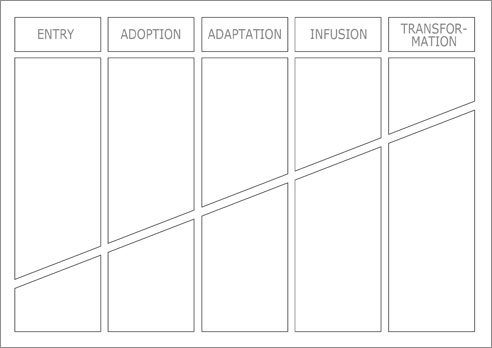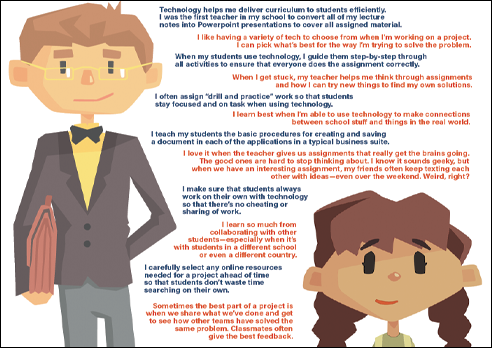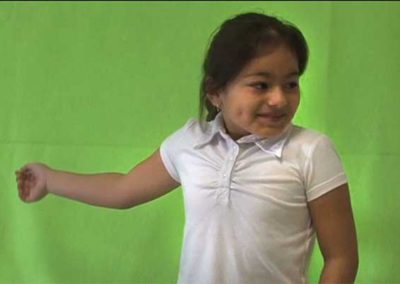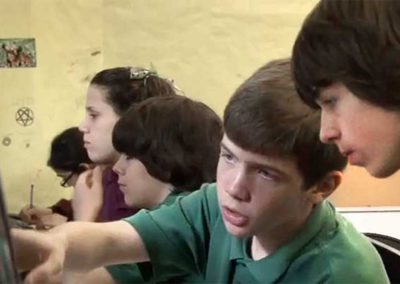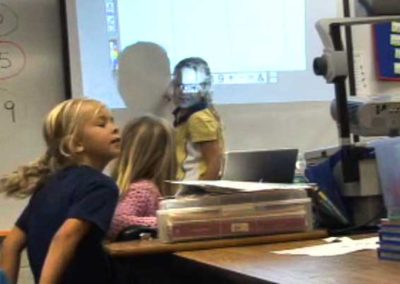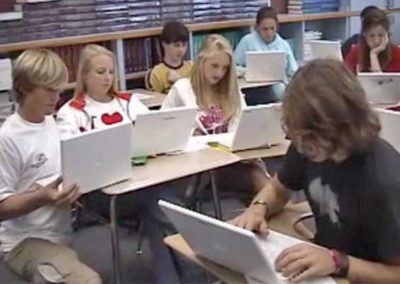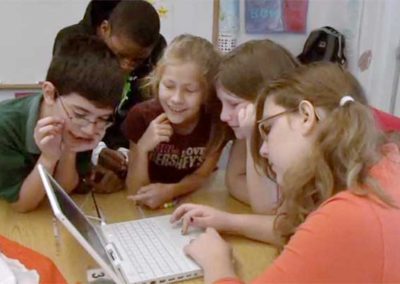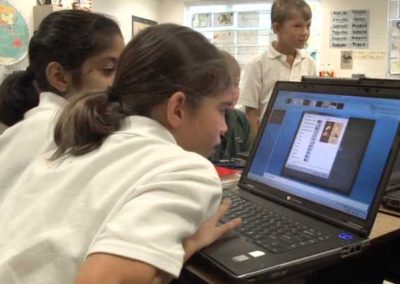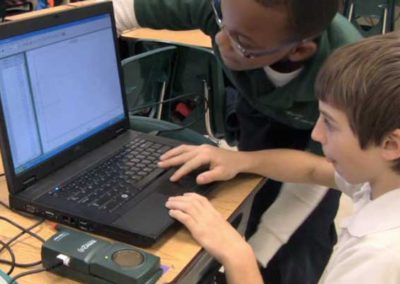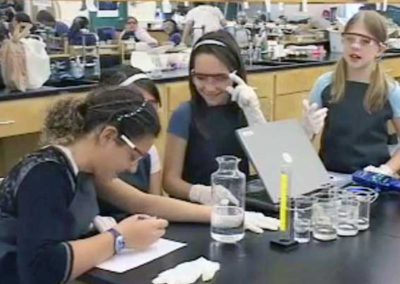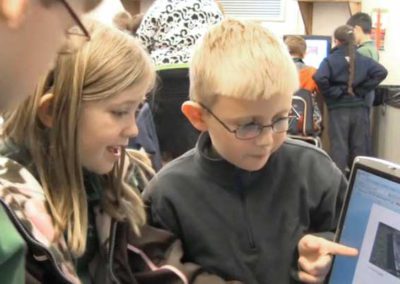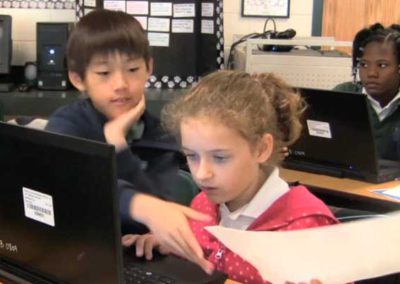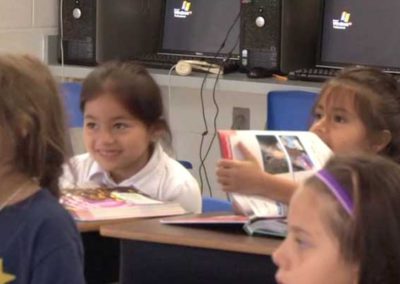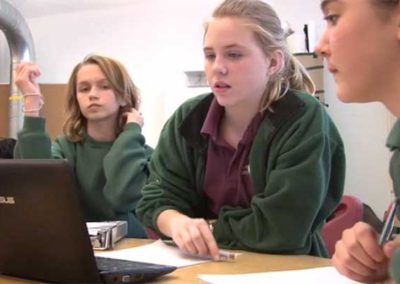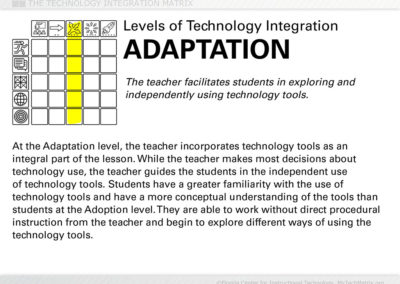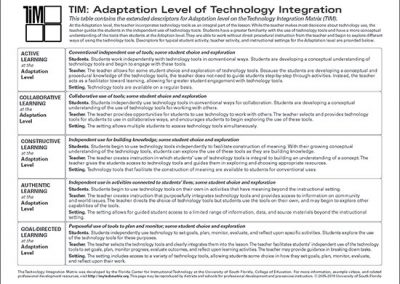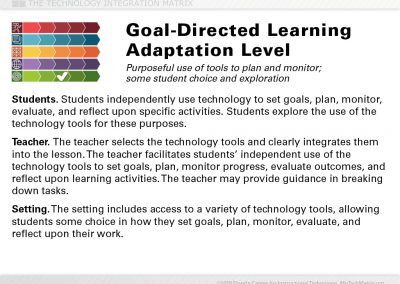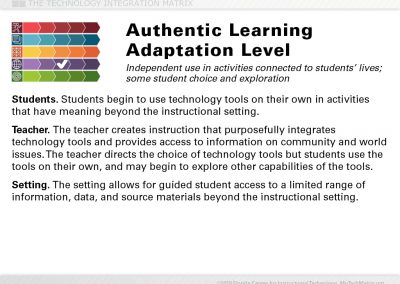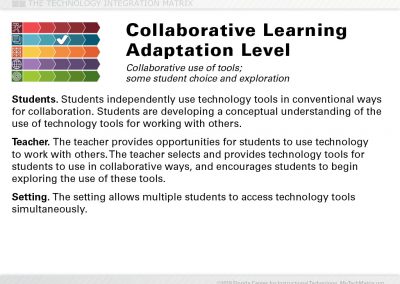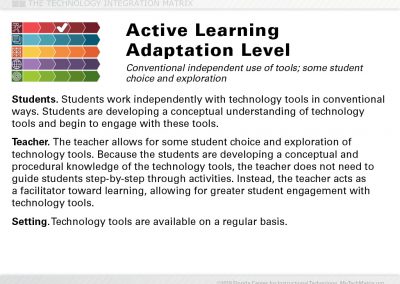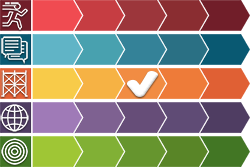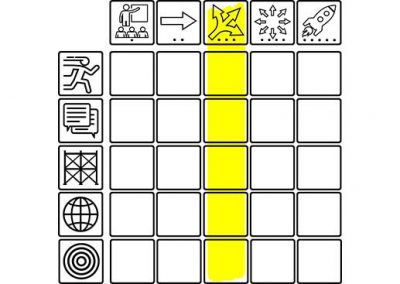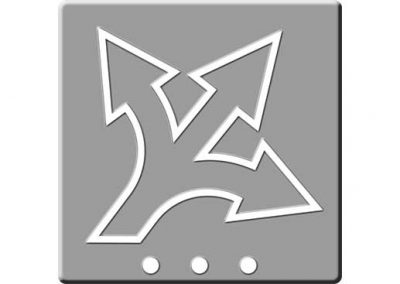The Adaptation Level
The teacher facilitates the students’ exploration and independent use of technology tools.
 At the Adaptation level, the teacher incorporates technology tools as an integral part of the lesson. While the teacher makes most decisions about technology use, the teacher guides the students in the independent use of technology tools. Students have a greater familiarity with the use of technology tools and have a more conceptual understanding of the tools than students at the Adoption level. They are able to work without direct procedural instruction from the teacher and begin to explore different ways of using the technology tools.
At the Adaptation level, the teacher incorporates technology tools as an integral part of the lesson. While the teacher makes most decisions about technology use, the teacher guides the students in the independent use of technology tools. Students have a greater familiarity with the use of technology tools and have a more conceptual understanding of the tools than students at the Adoption level. They are able to work without direct procedural instruction from the teacher and begin to explore different ways of using the technology tools.
This page provides greater detail about the Adaptation level of the Technology Integration Matrix. To see the entire matrix or to locate other levels, return to the Matrix. Descriptors for typical teacher activity, student activity, and instructional settings at the Adaptation level are provided below, along with links to all of the Adaptation level video lesson pages and additional resources.
Adaptation Level Descriptors for Each of the Five Characteristics
Active Learning
Conventional independent use of tools; some student choice and exploration
Students work independently with technology tools in conventional ways. Students are developing a conceptual understanding of technology tools and begin to engage with these tools.
The teacher allows for some student choice and exploration of technology tools. Because the students are developing a conceptual and procedural knowledge of the technology tools, the teacher does not need to guide students step-by-step through activities. Instead, the teacher acts as a facilitator toward learning, allowing for greater student engagement with technology tools.
Technology tools are available on a regular basis.
Collaborative Learning
Collaborative use of tools; some student choice and exploration
Students independently use technology tools in conventional ways for collaboration. Students are developing a conceptual understanding of the use of technology tools for working with others.
The teacher provides opportunities for students to use technology to work with others. The teacher selects and provides technology tools for students to use in collaborative ways, and encourages students to begin exploring the use of these tools.
The setting allows multiple students to access technology tools simultaneously.
Constructive Learning
Independent use for building knowledge; some student choice and exploration
Students begin to use technology tools independently to facilitate construction of meaning. With their growing conceptual understanding of the technology tools, students can explore the use of these tools as they are building knowledge.
The teacher creates instruction in which students use of technology tools is integral to building an understanding of a concept. The teacher gives the students access to technology tools and guides them in exploring and choosing appropriate resources.
Technology tools that facilitate the construction of meaning are available to students for conventional uses.
Authentic Learning
Independent use in activities connected to students’ lives; some student choice and exploration
Students begin to use technology tools on their own in activities that have meaning beyond the instructional setting.
The teacher creates instruction that purposefully integrates technology tools and provides access to information on community and world issues. The teacher directs the choice of technology tools, but students use the tools on their own, and may begin to explore other capabilities of the tools.
The setting allows for guided student access to a limited range of information, data, and source materials beyond the instructional setting.
Goal-Directed Learning
Purposeful use of tools to plan and monitor; some student choice and exploration
Students have opportunities to independently use technology tools to facilitate goal-setting, planning, monitoring, and evaluating specific activities. Students explore the use of the technology tools for these purposes.
The teacher selects the technology tools and clearly integrates them into the lesson. The teacher facilitates students’ independent use of the technology tools to set goals, plan, monitor progress, evaluate outcomes, and reflect upon learning activities. The teacher may provide guidance in breaking down tasks.
The setting includes access to technology tools (such as graphic organizers, calendars, spreadsheet software, and timeline software) for planning, monitoring progress, and evaluating outcomes.
View or print table as PDF:
US Letter
International A4
Understanding TIM Levels
The Invisible Technology Integration Matrix
There are also some “invisible” dimensions to the TIM. The invisible dimensions underlie the movement from left to right.... (Continue reading)
Tech Exploration in the Classroom
The emphasis on not only allowing, but also encouraging, exploration is no accident. In our busy schedules we.... (Continue reading)
What do we mean by “independent access”?
The spirit of independent use is that a student can evaluate a situation and choose the hardware or software that the student thinks will be most.... (Continue reading)
Ownership of Learning with Technology
One of the most important concepts behind the TIM is the ownership of learning. At lower levels of.... (Continue reading)
Adaptation Level Videos: Active Learning Characteristic
Adaptation Level Videos: Collaborative Learning Characteristic
Adaptation Level Videos: Constructive Learning Characteristic
Adaptation Level Videos: Authentic Learning Characteristic
Adaptation Level Videos: Goal-Directed Learning Characteristic

